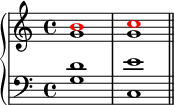
Back حساسة (موسيقى) Arabic Sensible Catalan Citlivý tón Czech Ledetone Danish Leitton German Strebotono Esperanto Sensible (música) Spanish محسوس (موسیقی) Persian Johtosävel Finnish Sensible (musique) French

In music theory, a leading-tone (also called a subsemitone, and a leading-note in the UK) is a note or pitch which resolves or "leads" to a note one semitone higher or lower, being a lower and upper leading-tone, respectively. Typically, the leading tone refers to the seventh scale degree of a major scale (![]() ), a major seventh above the tonic. In the movable do solfège system, the leading-tone is sung as ti.
), a major seventh above the tonic. In the movable do solfège system, the leading-tone is sung as ti.
A leading-tone triad is a triad built on the seventh scale degree in a major key (viio in Roman numeral analysis), while a leading-tone seventh chord is a seventh chord built on the seventh scale degree (viiø7). Walter Piston considers and notates viio as V0
7, an incomplete dominant seventh chord.[1] (For the Roman numeral notation of these chords, see Roman numeral analysis.)
- ^ Goldman 1965, 17.
© MMXXIII Rich X Search. We shall prevail. All rights reserved. Rich X Search